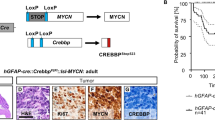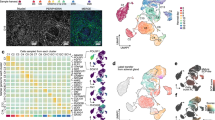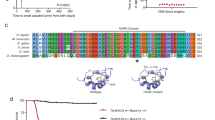Abstract
Neuroblastoma is an embryonal tumor with a heterogeneous clinical course. The tumor is presumed to be derived from the neural crest, but the cells of origin remain to be determined. To date, few recurrent genetic changes contributing to neuroblastoma formation, such as amplification of the MYCN oncogene and activating mutations of the ALK oncogene, have been identified. The possibility to model neuroblastoma in mice allows investigation of the cell of origin hypothesis in further detail. Here we present the evidence that murine neural crest progenitor cells can give rise to neuroblastoma upon transformation with MYCN or ALKF1174L. For this purpose we used JoMa1, a multipotent neural crest progenitor cell line, which is kept in a viable and undifferentiated state by a tamoxifen-activated c-Myc transgene (c-MycERT). Expression of MYCN or ALKF1174L, one of the oncogenic ALK variants identified in primary neuroblastomas, enabled these cells to grow independently of c-MycERT activity in vitro and caused formation of neuroblastoma-like tumors in vivo in contrast to parental JoMa1 cells and JoMa1 cells-expressing TrkA or GFP. Tumorigenicity was enhanced upon serial transplantation of tumor-derived cells, and tumor cells remained susceptible to the MYC-inhibitor, NBT-272, indicating that cell growth depended on functional MYCN. Our findings support neural crest progenitor cells as the precursor cells of neuroblastoma, and indicate that neuroblastomas arise as their malignant progeny.
This is a preview of subscription content, access via your institution
Access options
Subscribe to this journal
Receive 50 print issues and online access
$259.00 per year
only $5.18 per issue
Buy this article
- Purchase on SpringerLink
- Instant access to full article PDF
Prices may be subject to local taxes which are calculated during checkout



Similar content being viewed by others

References
Maris JM . Recent advances in neuroblastoma. N Engl J Med 2010; 362: 2202–2211.
Beckwith JB, Perrin EV . In Situ Neuroblastomas: a contribution to the natural history of neural crest tumors. Am J Pathol 1963; 43: 1089–1104.
De Preter K, Vandesompele J, Heimann P, Yigit N, Beckman S, Schramm A et al. Human fetal neuroblast and neuroblastoma transcriptome analysis confirms neuroblast origin and highlights neuroblastoma candidate genes. Genome Biol 2006; 7: R84.
Weiss WA, Aldape K, Mohapatra G, Feuerstein BG, Bishop JM . Targeted expression of MYCN causes neuroblastoma in transgenic mice. EMBO J 1997; 16: 2985–2995.
Barker N, Ridgway RA, van Es JH, van de Wetering M, Begthel H, van den Born M et al. Crypt stem cells as the cells-of-origin of intestinal cancer. Nature 2009; 457: 608–611.
Bonnet D, Dick JE . Human acute myeloid leukemia is organized as a hierarchy that originates from a primitive hematopoietic cell. Nat Med 1997; 3: 730–737.
Gibson P, Tong Y, Robinson G, Thompson MC, Currle DS, Eden C et al. Subtypes of medulloblastoma have distinct developmental origins. Nature 2010; 468: 1095–1099.
Johnson RA, Wright KD, Poppleton H, Mohankumar KM, Finkelstein D, Pounds SB et al. Cross-species genomics matches driver mutations and cell compartments to model ependymoma. Nature 2010; 466: 632–636.
Riggi N, Suva ML, Suva D, Cironi L, Provero P, Tercier S et al. EWS-FLI-1 expression triggers a Ewing’s sarcoma initiation program in primary human mesenchymal stem cells. Cancer Res 2008; 68: 2176–2185.
Maurer J, Fuchs S, Jager R, Kurz B, Sommer L, Schorle H . Establishment and controlled differentiation of neural crest stem cell lines using conditional transgenesis. Differentiation 2007; 75: 580–591.
Jager R, Maurer J, Jacob A, Schorle H . Cell type-specific conditional regulation of the c-myc proto-oncogene by combining Cre/loxP recombination and tamoxifen-mediated activation. Genesis 2004; 38: 145–150.
von Bueren AO, Shalaby T, Rajtarova J, Stearns D, Eberhart CG, Helson L et al. Anti-proliferative activity of the quassinoid NBT-272 in childhood medulloblastoma cells. BMC Cancer 2007; 7: 19.
Schulte JH, Pentek F, Hartmann W, Schramm A, Friedrichs N, Ora I et al. The low-affinity neurotrophin receptor, p75, is upregulated in ganglioneuroblastoma/ganglioneuroma and reduces tumorigenicity of neuroblastoma cells in vivo. Int J Cancer 2009; 124: 2488–2494.
Martin-Zanca D, Oskam R, Mitra G, Copeland T, Barbacid M . Molecular and biochemical characterization of the human trk proto-oncogene. Mol Cell Biol 1989; 9: 24–33.
Swartling FJ, Grimmer MR, Hackett CS, Northcott PA, Fan QW, Goldenberg DD et al. Pleiotropic role for MYCN in medulloblastoma. Genes Dev 2010; 24: 1059–1072.
Soucek L, Whitfield J, Martins CP, Finch AJ, Murphy DJ, Sodir NM et al. Modelling Myc inhibition as a cancer therapy. Nature 2008; 455: 679–683.
Zender L, Xue W, Zuber J, Semighini CP, Krasnitz A, Ma B et al. An oncogenomics-based in vivo RNAi screen identifies tumor suppressors in liver cancer. Cell 2008; 135: 852–864.
Pajtler K, Bohrer A, Maurer J, Schorle H, Schramm A, Eggert A et al. Production of chick embryo extract for the cultivation of murine neural crest stem cells. J Vis Exp 2010. Epub 2010/12/24.
Schulte JH, Lim S, Schramm A, Friedrichs N, Koster J, Versteeg R et al. Lysine-specific demethylase 1 is strongly expressed in poorly differentiated neuroblastoma: implications for therapy. Cancer Res 2009; 69: 2065–2071.
Hata K, Tolba RH, Wei L, Doorschodt BM, Buttner R, Yamamoto Y et al. Impact of polysol, a newly developed preservation solution, on cold storage of steatotic rat livers. Liver Transpl 2007; 13: 114–121.
Schulte JH, Schramm A, Klein-Hitpass L, Klenk M, Wessels H, Hauffa BP et al. Microarray analysis reveals differential gene expression patterns and regulation of single target genes contributing to the opposing phenotype of TrkA- and TrkB-expressing neuroblastomas. Oncogene 2005; 24: 165–177.
Schulte JH, Schowe B, Mestdagh P, Kaderali L, Kalaghatgi P, Schlierf S et al. Accurate prediction of neuroblastoma outcome based on miRNA expression profiles. Int J Cancer 2010; 127: 2374–2385.
Acknowledgements
We thank E Mahlow, S Dreesmann, A Odersky and M Baumann for their excellent technical assistance and K Astrahantseff for proof reading the manuscript. This work was supported by the German National Genome Research Network (NGFN plus grant no. PKN-01GS0894-6 to JHS, AE and AS) and by the German Cancer Aid (grant no. 108941 to JHS and AE).
Author information
Authors and Affiliations
Corresponding author
Ethics declarations
Competing interests
The authors declare no conflict of interest.
Additional information
Supplementary Information accompanies the paper on the Oncogene website
Rights and permissions
About this article
Cite this article
Schulte, J., Lindner, S., Bohrer, A. et al. MYCN and ALKF1174L are sufficient to drive neuroblastoma development from neural crest progenitor cells. Oncogene 32, 1059–1065 (2013). https://doi.org/10.1038/onc.2012.106
Received:
Revised:
Accepted:
Published:
Issue Date:
DOI: https://doi.org/10.1038/onc.2012.106


